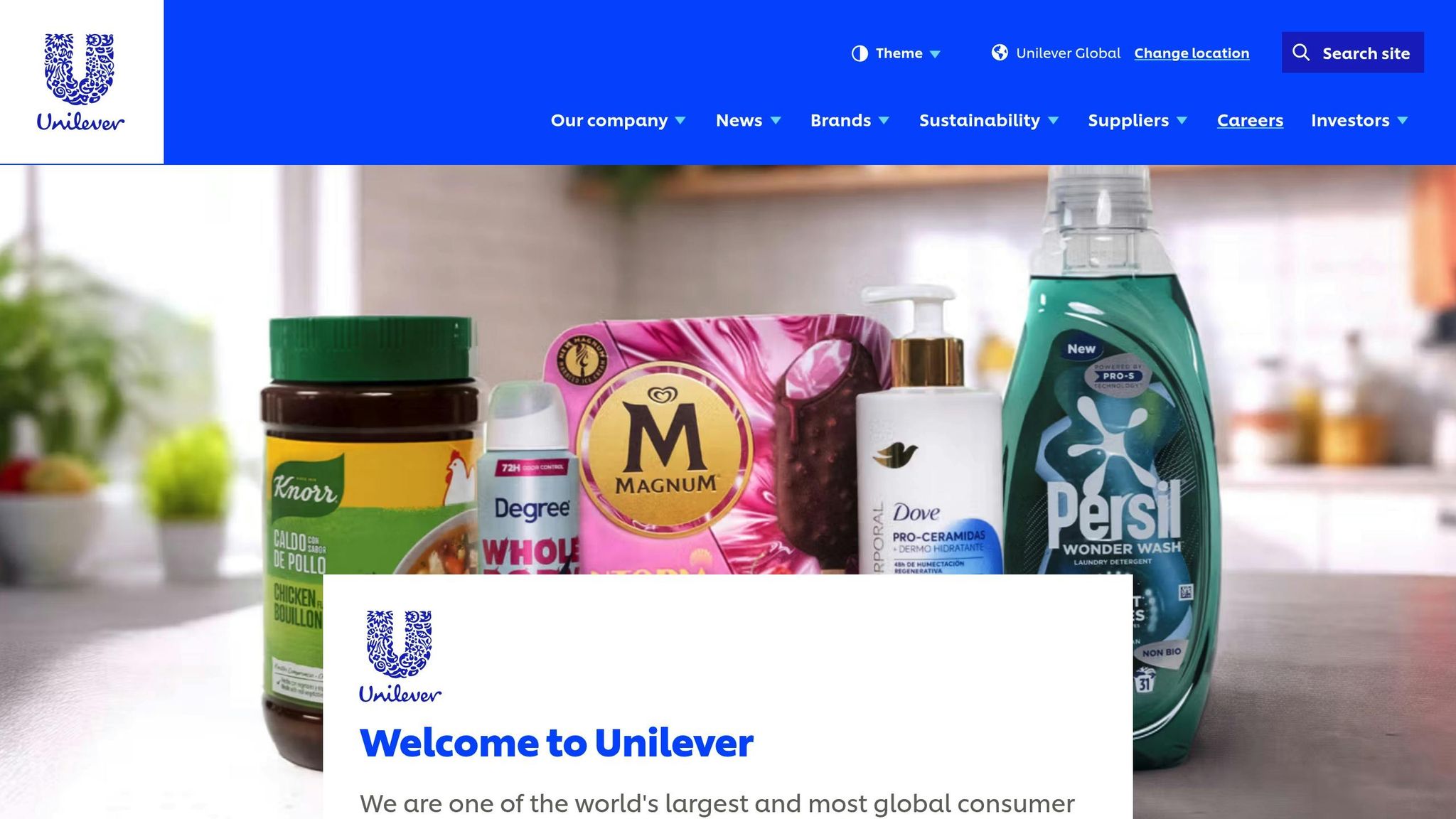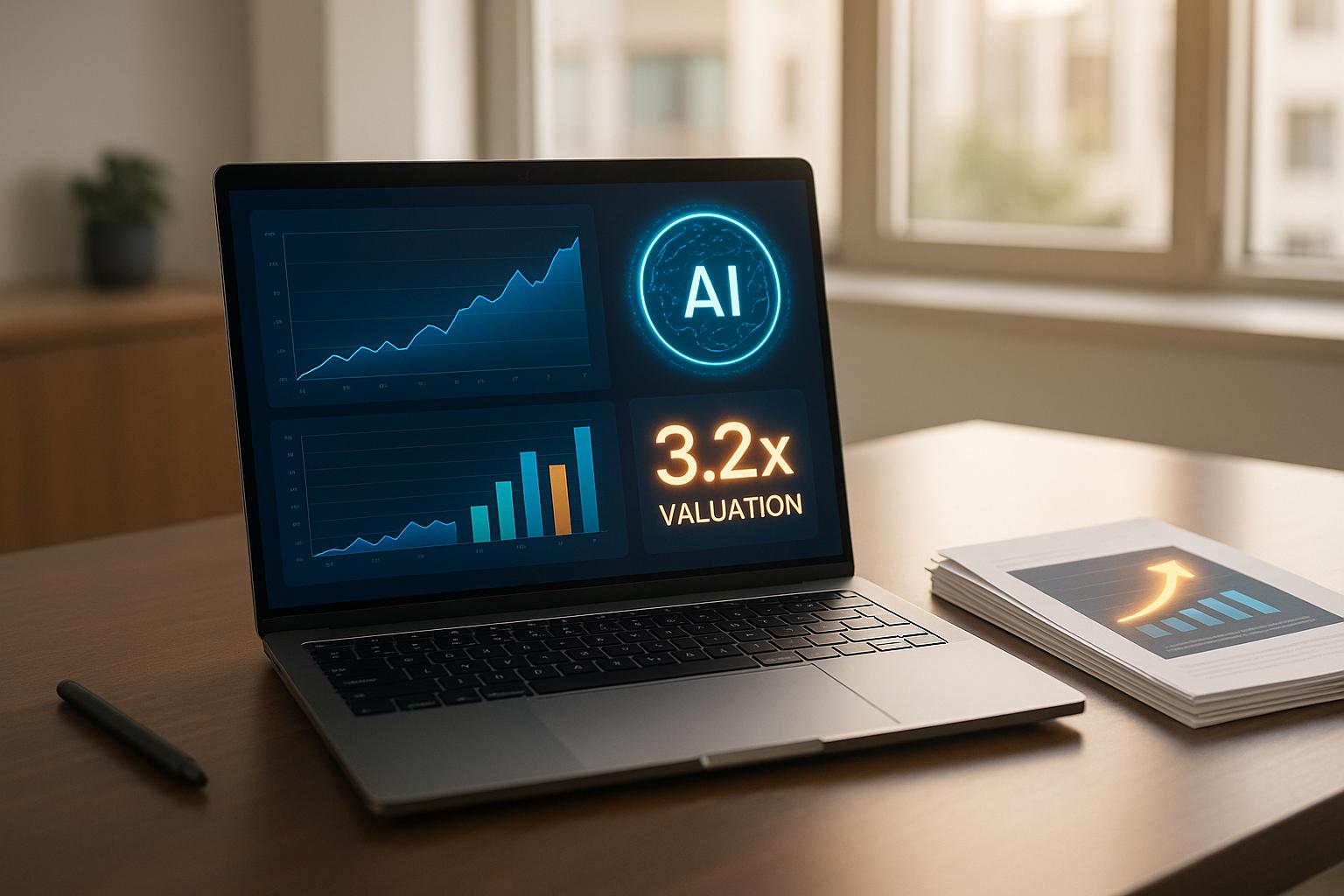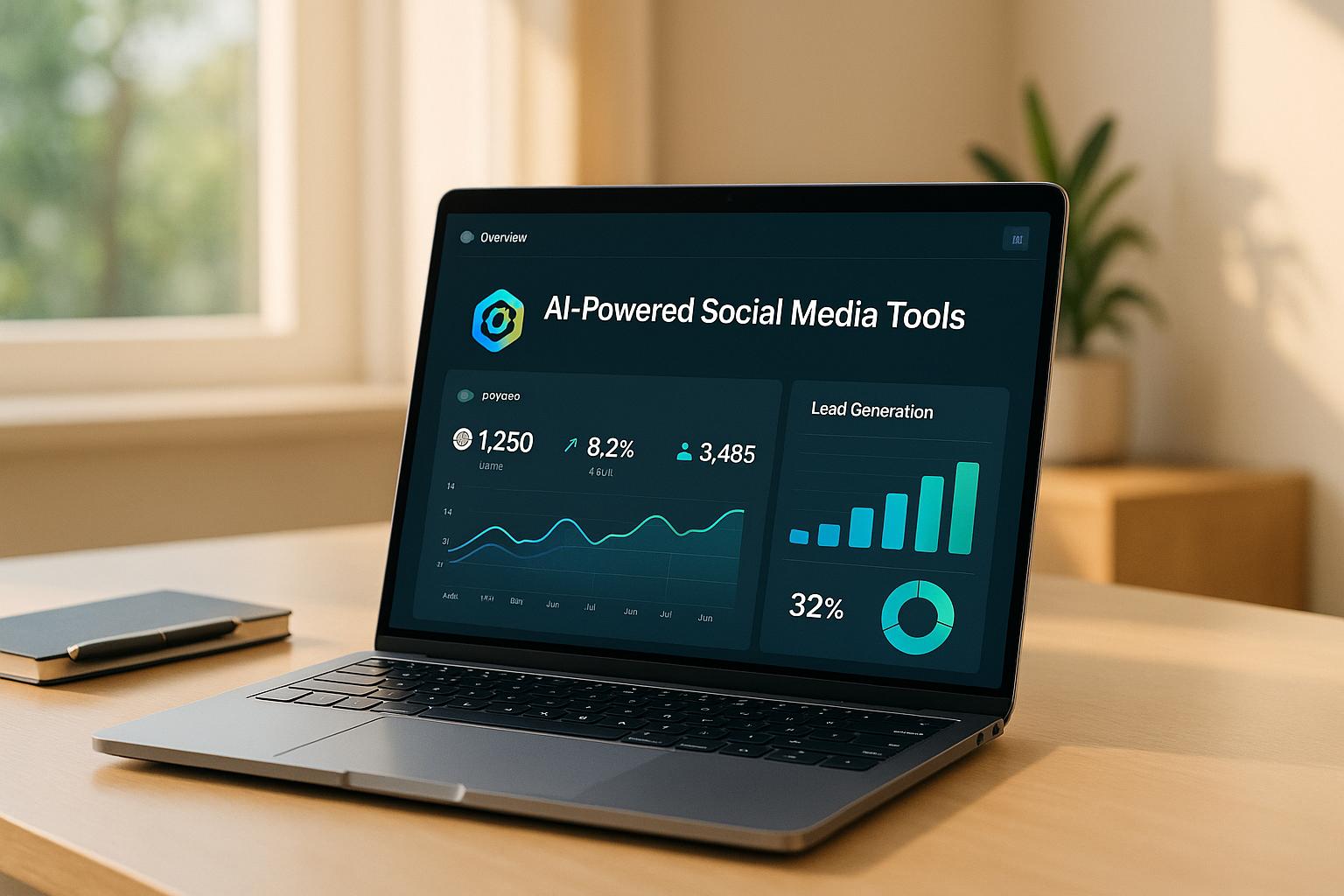AI is transforming marketing by enabling brands to deliver highly personalized, data-driven campaigns that resonate with audiences. Companies like Unilever and Delta are leading the way, using AI to optimize content creation, predict trends, and measure ROI in real time. Here’s how they’re doing it:
- Unilever: Uses AI for faster, cost-effective content production (e.g., digital twins cut costs by 55%), personalized tools like Dove’s AI Scalp Therapist, and trend forecasting to launch viral campaigns like #VaselineHacks.
- Delta: Leverages AI for personalized pricing, real-time campaign tracking (e.g., $30M in sales from Olympic ads), and predictive analytics for better customer experiences.
Both companies show how AI can improve efficiency, boost engagement, and drive measurable business results.
AI for Marketing | 10 Exceptional AI Marketing Campaign Examples | Learnbay
Delta's AI Strategies for Viral Engagement
Delta Air Lines has revolutionized its approach to marketing by using AI to directly link campaigns to sales outcomes. By aligning every marketing dollar with actual revenue, tailoring customer experiences, and employing cutting-edge modeling techniques, Delta has reshaped how it executes viral marketing campaigns.
AI-Powered Attribution and ROI Measurement
Delta made a major leap in marketing effectiveness by teaming up with Alembic Technologies to tackle a persistent problem: proving that advertising truly drives sales. With Alembic's Marketing Intelligence Platform, Delta can now track exactly how many customers book tickets after encountering its ads across various platforms. For example, during its Olympic sponsorship campaign, Delta attributed over $30 million in cash sales to its marketing efforts[5].
"I was able to analyze, in near real-time, the money I was investing across various media assets, such as broadcast. For example, we placed numerous broadcast spots for Delta during key Olympic moments... This led to our pilot project with Alembic, where I was able to demonstrate that we generated over $30 million in cash sales during the Olympics." - Alicia Tillman, CMO, Delta Air Lines[5]
By consolidating data from TV, social media, and other sources, the platform provides a unified view of campaign performance. This allows Delta's marketing team to pinpoint which strategies deliver results, showcasing real financial impact instead of relying solely on metrics like clicks or impressions[6]. These insights also pave the way for more personalized customer interactions.
Personalized Advertising for Higher Engagement
Delta is rethinking ticket pricing and advertising by embracing AI-driven personalization. The airline is moving away from generic pricing models, instead focusing on individualized pricing strategies that factor in customer behavior, preferences, and willingness to pay. Currently, AI determines 3% of Delta's flight prices, with plans to scale this to 20% by the end of the year[8].
To refine these personalized offers, Delta has partnered with Fetcherr, an Israeli AI travel tech company. Fetcherr's system evaluates travel patterns, booking habits, and price sensitivity to craft tailored offers that are more likely to result in bookings[9].
"Delta is thinking differently about how we blend the digital and physical experiences, starting with the Fly Delta app... Our vision for Delta Concierge is that it will serve as an AI-powered personal assistant that combines the context of who our customers are and how they like to travel, with the deep knowledge and insights we've built as the world's most reliable airline." - Ed Bastian, CEO[7]
This approach enhances more than just pricing - it elevates the entire customer experience with targeted travel ads and personalized offers.
Digital Twins and Predictive Analytics
Delta is also leveraging digital twins and predictive analytics to optimize its operations. Delta Electronics, a separate entity from Delta Air Lines, has pioneered the use of digital twins for testing and improving production processes. By utilizing NVIDIA Omniverse and Universal Scene Description, the company creates virtual replicas of production systems to simulate various scenarios before implementing changes. This approach has led to 90% accuracy in results, cut testing time by 99%, and boosted synthetic data generation by over 100 times with advanced simulation tools[10].
"Using Isaac Sim and Omniverse Replicator has allowed us to significantly increase our synthetic data generation capabilities by over 100X, compared to previous methods of training. This greatly increases efficiencies and ultimately accelerates our designs of new production lines." - Ares Chen, PSBG General Manager, Delta Electronics[10]
From marketing to operations, Delta's AI strategies are setting new standards in efficiency and customer engagement.
Unilever's AI-Driven Content and Marketing

Unilever has integrated AI into its global operations on a massive scale, processing 240 terabytes of data every week and managing over 3 billion transactions. With more than 500 AI-powered tools in use worldwide, the company is also investing in its workforce, training 23,000 employees in AI by the end of 2024 [15]. Let’s dive into how AI is reshaping Unilever’s content creation, social media strategies, and trend forecasting to fuel viral marketing campaigns.
AI-Powered Content Creation and Analysis
Unilever’s use of digital twins - virtual replicas of its products - has revolutionized content creation. Brands like Dove can now produce content twice as fast and at half the cost of traditional methods [1]. These tools have enabled Unilever’s Beauty & Wellbeing brands to cut costs by up to 55% and speed up content production by 65%, all while doubling click-through rates and tripling user engagement [1][12].
"Our product twins can be deployed everywhere and anywhere, accurately and consistently, so content is generated faster and on brand. We call it creativity at the speed of life."
– Esi Eggleston Bracey, Unilever's Chief Growth & Marketing Officer [1]
In Thailand, TRESemmé has seen an 87% drop in content creation costs and a 5% boost in purchase intent thanks to digital twins [2][12]. This technology allows brands to seamlessly adapt content for different platforms, languages, and packaging needs without starting from scratch.
Unilever is also using AI to deliver personalized consumer experiences. For example, Dove launched a virtual AI-powered Scalp + Hair Therapist in the U.S. in March 2024. This tool provides tailored product recommendations based on user feedback and links directly to Amazon for purchase [11]. Similarly, POND’S SKIN INSTITUTE rolled out its AI Skin Expert in Indonesia and the Philippines in late 2023. This tool analyzes selfies to identify skincare needs and recommend products, with over 30,000 consumers using it so far and projections to surpass 100,000 users by the end of 2024 [11].
Real-Time Social Media Optimization
Unilever is tapping into AI to stay ahead in the ever-changing social media landscape. Through a partnership with IPG Studios, the company developed Sketch Pro, which uses AI tools like Adobe Firefly and Google Veo 3 to create content optimized for social media [3]. This system enables Unilever to respond quickly to trending topics and cultural moments.
During Ramadan 2025, the Jakarta Sketch Pro Team leveraged this technology to boost the visibility of brands like Rinso and Sunlight on TikTok by 22.5% [3]. AI also helps Unilever decode social conversations in multiple languages, enhancing its ability to forecast demand and identify emerging trends [14].
"Our partnership with IPG supercharges our ability to ideate, iterate and deliver high-quality design assets with speed and cultural relevance, reflecting how consumers now engage with the home care category."
– Mario Dughi, Global Marketing Director at Unilever [3]
Recognizing that half of consumers discover brands on social media and that one in two makes influencer-driven purchases monthly [13], Unilever focuses on creating content that aligns with these behaviors.
Predictive Analytics for Trend Forecasting
Unilever goes beyond reacting to trends - it predicts them. By analyzing social conversations, consumer habits, and market signals, its AI systems can identify what will resonate with audiences before trends take off.
Take the viral hashtag #VaselineHacks, for example. Gen Z users shared creative ways to use Vaseline, and Unilever’s R&D team verified these hacks, awarding official #VaselineVerified status to selected tips. This campaign earned a Titanium award at the Cannes International Festival of Creativity [14].
In another instance, Dove partnered with Crumbl Cookies in December 2024 to create a limited-edition body care line sold at Walmart. This collaboration became Dove’s top launch in 2025, showcasing how predictive analytics can guide successful product development [14].
"Advanced AI compresses lab work into days, accelerating innovation."
– Aaron Rajan, VP of Consumer Technology at Unilever [14]
Unilever also leverages predictive analytics in product innovation. For example, AI tools helped predict consumer preferences for Hellman’s Vegan mayonnaise, streamlining product design and reducing lab work [16]. Similarly, digital modeling was used to perfect the Knorr Zero Salt Cube, ensuring taste and texture without sodium [16].
The BeautyHub PRO platform is another example of Unilever’s data-driven approach. Consumers who use the platform for recommendations are 43% more likely to make a purchase, while marketing assets informed by its data have seen a 23% increase in ad recall and a 7% rise in purchase intent [11].
"Technology is powering a digital beauty revolution and changing how brands communicate. By delivering breakthrough immersive beauty experiences, we can drive science, build desirability, and deliver cut-through in an unexpected way."
– Zoe Eungblut, Beauty & Wellbeing Digital Strategy Director [11]
sbb-itb-9cd970b
AI Tools That Drive Viral Campaigns
Delta and Unilever have demonstrated how AI strategies can reshape marketing efforts. The tools highlighted below showcase the technology enabling campaigns to go viral through rapid execution, personalized content, and predictive insights. These platforms are redefining how businesses craft content, connect with audiences, and track success in real time.
Key AI Platforms: Features and Use Cases
Sketch Pro is Unilever's premier AI-powered content creation tool, developed in collaboration with IPG Studios.
"Our partnership with IPG supercharges our ability to ideate, iterate and deliver high-quality design assets with speed and cultural relevance, reflecting how consumers now engage with the home care category." – Mario Dughi, Global Marketing Director at Unilever [3]
Nvidia's Omniverse supports Unilever's digital twin technology, which creates virtual product replicas for generating engaging content. This approach has led to a 65% faster content production process and a 55% reduction in costs, particularly benefiting brands like Tresemmé, Dove, Vaseline, and Clear [2].
AI-Enabled Freezers are revolutionizing sales strategies by aligning product placement with consumer behavior. These smart freezers analyze data to optimize product arrangements, resulting in an 8% sales boost in Turkey, 12% in the US, and 30% in Denmark [17].
DeepIntent's platform leverages AI to identify and engage physicians instantly, enabling earlier prescriptions and improving patient access to treatments [20].
Here’s a quick comparison of these tools and their impact:
AI Tools Comparison for Viral Marketing
| Tool Category | Primary Function | Speed Improvement | Cost Reduction | Best Use Case |
|---|---|---|---|---|
| Sketch Pro | Social content creation | 3x faster delivery | Not specified | Quick response to trends |
| Digital Twins (Nvidia) | Product visualization | 2x faster production | 50% cost reduction | Multi-platform content |
| AI-Enabled Freezers | Predictive placement | Real-time optimization | 8-30% sales increase | Retail optimization |
The power of predictive analytics is clear: 86% of executives report improved ROI, with adopters seeing a 10% revenue increase and a 10% cut in marketing expenses [19]. Companies using AI for content analysis report a 25% boost in effectiveness, while those employing AI for content strategy see a 20% rise in ROI [18].
Using the Top SaaS & AI Tools Directory
To help businesses harness these capabilities, the Top SaaS & AI Tools Directory offers a curated guide for discovering and implementing AI solutions. With 80% of marketers either using or planning to use AI in their strategies [18], this resource is essential for staying ahead in a competitive market.
The directory provides insights into areas like lead generation, sales optimization, marketing automation, and content creation - key components of viral campaigns. It also includes expert training and tailored SaaS recommendations, reinforcing the importance of AI in modern marketing.
"AI is no longer a nice-to-have, but a must-have for businesses looking to stay competitive in today's market." – Brian Halligan, HubSpot's CEO [18]
Companies leveraging AI tools from this directory have reported an average 15% increase in ROI and a 20% improvement in customer engagement [18]. By identifying tools that address specific marketing gaps, businesses can streamline processes and adopt best practices for seamless AI integration.
How to Adopt AI in US-Based Marketing
Unilever and Delta have shown that AI isn’t just for tech giants - it’s a game-changer for businesses of all sizes. With 84% of marketing organizations already using AI [23], the real question for US marketers isn’t whether they should adopt it, but how to do it effectively.
Personalized Content and Targeted Advertising
In today’s market, US consumers expect tailored experiences, and AI makes it possible to deliver them on a large scale. Businesses using AI-driven personalization have reported an average revenue boost of 15% [23], while personalized emails can achieve a 56.7% higher click-through rate [21]. The goal is to move beyond simple demographic targeting and focus on behavior-based personalization.
Take HOLT CAT, for example. This heavy equipment company used AI-powered advertising to craft personalized messages for talent recruitment, which led to a 20% lower cost per hire and 270 new hires [25]. Vanguard, on the other hand, utilized an AI language platform to fine-tune LinkedIn ads, achieving a 15% increase in conversion rates [25].
AI doesn’t stop at ads - it can also analyze user behavior in real time to create dynamic website content, personalized product recommendations, and targeted messaging that keeps users engaged [26]. According to McKinsey, companies experiencing rapid growth generate 40% more revenue from hyper-personalization compared to their competitors [26]. Tools like Adobe Target, Braze, and Dynamic Yield offer scalable solutions that adapt to a business’s size and needs [26].
Real-Time ROI Measurement and Campaign Adjustment
One of the biggest challenges in traditional marketing is the delay in performance data. AI flips the script by providing real-time insights, allowing marketers to tweak campaigns as they run. For example, RedBalloon used Albert, an AI platform, to achieve a 3,000% return on ad spend (ROAS) and cut costs by 25% [25]. Similarly, The Independent increased its click-through rates by 43% and ad revenue by 14% using predictive recommendations [22].
AI platforms can process massive amounts of data in seconds, enabling marketers to pause underperforming campaigns, reallocate budgets to better-performing segments, and test new strategies without wasting time or resources.
Using Predictive Analytics for Timing and Trends
The timing of a campaign can make all the difference between success and failure. Predictive analytics helps businesses pinpoint the best moments to engage their audience and identify trends before competitors do. By 2032, the predictive analytics market is expected to reach $55.5 billion, underscoring its growing role in marketing strategies [27].
Predictive tools analyze customer data and past trends to uncover patterns. FreedomPop, for instance, used a lead scoring system powered by predictive analytics to attract thousands of new subscribers in Spain at just $0.10 per click [22][28]. This approach not only identifies the best times to engage customers but also flags at-risk segments and emerging trends early.
"Predictive analytics will allow us to offer proactive insights, helping clients make more informed decisions without waiting for manual analysis. This shift will enable us to spend more time on strategy and optimization, ensuring our clients get the most value from their campaigns."
– Christian Watson, Co-Founder, Local Propeller [27]
For US marketers, understanding seasonal patterns, regional preferences, and key events is crucial for timing campaigns effectively. Tailored recommendations can lead to a 20% increase in customer satisfaction [22]. Platforms listed in the Top SaaS & AI Tools Directory can help businesses find the right tools for trend forecasting and timing, enabling a proactive approach to marketing.
"AI will empower those who use it effectively."
– Christina Inge, Author of Marketing Analytics: A Comprehensive Guide and Marketing Metrics and instructor at Harvard’s Professional & Executive Development program [4]
From hyper-personalized ads to predictive analytics, these AI-driven strategies offer scalable solutions for US-based marketers. Success starts with selecting tools that address immediate needs, prioritizing behavior-based personalization, maintaining transparency about AI’s role, and ensuring human oversight for ethical and accurate execution [4][24]. These steps pave the way for agile, forward-thinking marketing that aligns with industry leaders’ best practices.
Conclusion: The Future of AI-Powered Marketing
The marketing world is evolving at lightning speed, and companies like Unilever and Delta are proving how AI can merge data-driven precision with emotional resonance to craft campaigns that genuinely connect with audiences.
Lessons from Unilever and Delta
One standout takeaway is the sheer speed and scale that AI makes possible. Unilever's dramatic shift from small-scale deployments to producing thousands of marketing assets weekly highlights AI's transformative potential. Steve McCrystal, Chief Enterprise and Technology Officer at Unilever, shared:
"We're now deploying thousands of assets a week across our brands, compared to single digits over months" [30].
This agility gives brands a competitive edge, allowing them to track performance in real time and tweak campaigns on the fly. For instance, the Dove x Crumbl campaign achieved over 3.5 billion impressions and a 52% conversion rate, with more than half of the purchases coming from first-time Dove buyers [29][30].
Another critical strategy is adopting a social-first mindset. Unilever, for example, plans to allocate up to 50% of its marketing budget to influencer and AI-powered campaigns [29]. They’re also aiming to expand their influencer network by 10 to 20 times in the coming year [30].
But perhaps the most impactful lesson is the ability to listen at scale. Using AI, companies can analyze conversations across languages and platforms, spotting trends and shifts before competitors even notice. Aaron Rajan, VP of Consumer Technology at Unilever, highlighted this advantage:
"Using advanced computing power and AI, we're able to compress decades of lab work into days, and by mapping, modelling and experimenting virtually, we're innovating faster than ever" [14].
These insights show that businesses can move beyond merely learning from data to taking decisive, impactful action.
Steps for Businesses to Get Started
Inspired by these success stories, businesses - big or small - can embrace AI to sharpen their competitive edge. With the AI market projected to hit $190.61 billion by 2025, growing at an annual rate of 36.62% [32], the opportunities are immense. Companies already using AI tools report up to double the conversion rates and a 50% boost in lead quality [32].
To begin, set clear objectives and evaluate your current marketing tools to find areas where AI can make the biggest difference. Focus on high-impact applications like content personalization, predictive analytics, and optimizing campaigns in real time. Starting with small pilot projects allows you to experiment and measure results before scaling up [31].
As demonstrated by Unilever and Delta, practical AI implementation delivers measurable outcomes. Equip your team with the knowledge to combine AI capabilities with human creativity to align with your business goals [35].
For those exploring AI solutions, the Top SaaS & AI Tools Directory is a valuable resource for finding tools tailored to your needs - whether for content creation, predictive analytics, or social listening.
Looking ahead, emerging trends like AI-driven automation, hyper-personalized experiences, and cookieless targeting are set to reshape marketing further [33][34]. Companies that embrace these innovations, following the lead of pioneers like Unilever and Delta, will be ready to craft the next wave of game-changing campaigns.
The future belongs to marketers who can blend AI’s capabilities with the creativity and strategic thinking that make campaigns unforgettable. The time to act is now.
FAQs
How are companies like Unilever and Delta using AI to create viral marketing campaigns?
Unilever is tapping into AI technologies to create buzzworthy campaigns. By producing personalized, social-first content, using digital twins for faster product imagery, and fine-tuning influencer marketing strategies, the company has found new ways to connect with audiences and stay ahead of trends.
Delta is also embracing AI to improve customer experiences and drive engagement. Through dynamic, personalized ticket pricing and AI-powered travel tools, the airline has tailored its services to better meet customer needs. By weaving AI into its revenue management processes, Delta has been able to influence a large share of its domestic flights while boosting both marketing and operational performance.
What are digital twins, and how do they help companies like Unilever create content more efficiently?
Digital twins are essentially 3D virtual replicas of real-world products or assets. They give businesses the ability to design, tweak, and customize items in a digital space, making the entire process faster and more affordable. By using digital twins, companies can cut production costs by as much as 70% while creating ultra-realistic visuals perfect for marketing.
Take Unilever, for example. By integrating digital twins into their workflow, they’ve managed to simplify content creation, saving both time and resources. This allows their teams to produce high-quality, tailored content on a large scale. The result? A more efficient process that powers marketing campaigns with engaging and visually stunning content.
How does Delta track the success of its AI-powered marketing campaigns in real time?
Delta keeps a close eye on how well its AI-driven marketing campaigns are doing by measuring critical factors like sales impact, customer engagement, and pricing sensitivity. Using advanced tools such as neural networks and marketing intelligence platforms, Delta processes massive amounts of data at lightning speed to uncover trends that shape campaign outcomes.
With these insights in hand, Delta adjusts its strategies on the fly to capture customer interest and achieve better results, ensuring its marketing stays sharp and responsive.



